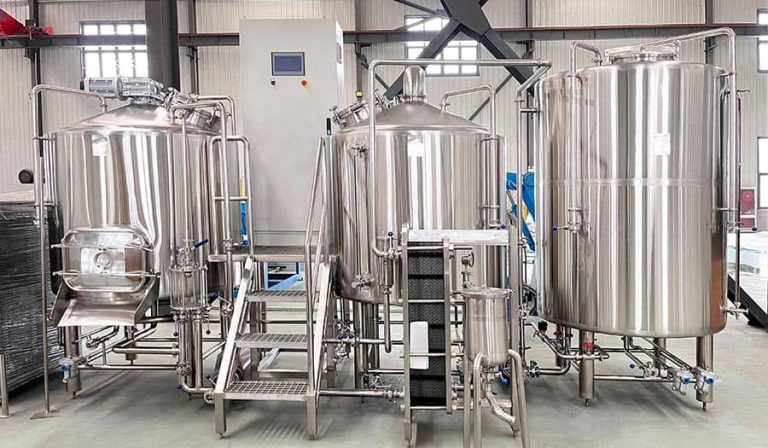Choosing the right fermenter size is a critical decision for any brewery, whether it’s a small nano-brewery or a larger microbrewery. Fermenter capacity affects production volume, batch consistency, equipment costs, and overall efficiency. This article explores the ideal fermenter sizes for nano-breweries and microbreweries, considering factors such as batch frequency, space constraints, and business growth potential.
1. Understanding Nano-Breweries vs. Microbreweries
Definition of a Nano-Brewery
A nano-brewery typically produces beer in very small batches, often 1-3 barrels (bbl) per batch (1 bbl = 31 gallons or 117 liters). These breweries focus on local distribution, taproom sales, or experimental batches.
Definition of a Microbrewery
A microbrewery produces beer on a larger scale, usually 7-15 bbl per batch, with annual production capped at 15,000 barrels in the U.S. Microbreweries often distribute regionally and may have a broader market reach than nano-breweries.
2. Ideal Fermenter Size for a Nano-Brewery
Recommended Size: 1-5 Barrels
Nano-breweries benefit from smaller fermenters (1-5 bbl) because:
- Lower Initial Investment – Smaller tanks are cheaper and require less space.
- Flexibility in Recipes – Allows for frequent small-batch experimentation.
- Easier to Manage – Less risk of spoilage if a batch goes wrong.
Common Fermenter Types for Nano-Breweries
- Conical Unitanks (3-5 bbl) – Combine fermentation and serving in one vessel.
- Plastic or Stainless Steel Buckets (1-2 bbl) – Affordable for startups.
Considerations for Nano-Breweries
- Batch Frequency – Smaller tanks mean more frequent brewing, which can be labor-intensive.
- Scaling Up – If demand grows, nano-breweries may need to upgrade to larger fermenters.
3. Ideal Fermenter Size for a Microbrewery
Recommended Size: 7-30 Barrels
Microbreweries typically use 7-15 bbl fermenters, with some expanding to 20-30 bbl as they grow. Benefits include:
- Higher Production Efficiency – Fewer batches needed to meet demand.
- Better Profit Margins – Larger batches reduce per-unit costs.
- Distribution Readiness – Suitable for kegging, bottling, and canning at scale.
Common Fermenter Types for Microbreweries
- Jacketed Conical Fermenters (10-30 bbl) – Allow precise temperature control.
- Bright Tanks (for conditioning) – Often the same size as fermenters for seamless transfer.
Considerations for Microbreweries
- Space Requirements – Larger tanks need more floor space and possibly reinforced flooring.
- Yeast Management – Bigger batches require careful yeast harvesting and repitching.
4. Key Factors Influencing Fermenter Size Choice
Production Goals
- Nano-Brewery → Focus on small, high-quality batches.
- Microbrewery → Aim for consistent, larger-scale production.
Available Space
- Nano-breweries often operate in tight spaces (e.g., garages, small storefronts).
- Microbreweries need dedicated brewery spaces with proper ventilation and drainage.
Budget Constraints
- Small fermenters (1-5 bbl) cost 1,000–1,000–10,000.
- Larger fermenters (10-30 bbl) can range from 15,000–15,000–50,000+.
Future Expansion
- Starting with slightly larger tanks (e.g., 7 bbl for a nano-brewery) can save money in the long run.
- Modular systems allow gradual scaling without replacing all equipment.
5. Pros and Cons of Small vs. Large Fermenters
Factor Small Fermenters (1-5 bbl) Large Fermenters (7-30 bbl) Cost Lower initial investment Higher upfront cost Batch Flexibility Great for experimentation Limited variety per batch Labor Intensity More frequent brewing Fewer, but larger, batches Profitability Lower margins per batch Higher efficiency & margins Space Needed Compact, fits small spaces Requires significant room
6. Case Studies: Real-World Examples
Nano-Brewery Example: Local Craft Experimentation
- Brewery Size: 3 bbl system
- Fermenters Used: Four 3 bbl conical fermenters
- Advantage: Allows rotating small-batch releases (IPAs, stouts, sours) without overcommitting to one beer.
Microbrewery Example: Regional Distribution
- Brewery Size: 15 bbl system
- Fermenters Used: Six 15 bbl jacketed fermenters + bright tanks
- Advantage: Supports canning and kegging for local bars and stores.
7. When to Upgrade Fermenter Size
Signs a Nano-Brewery Should Scale Up
- Consistently selling out within days.
- Needing to brew 4+ times a week to meet demand.
- Securing contracts with local bars/restaurants.
Signs a Microbrewery Should Expand Further
- Struggling to keep up with regional distribution.
- Considering packaging (cans/bottles) for retail.
- Planning to enter beer festivals or export markets.
Conclusion
The ideal fermenter size depends on the brewery’s production goals, space, and budget.
- Nano-breweries (1-5 bbl) → Best for small-batch, experimental brewing.
- Microbreweries (7-30 bbl) → Optimal for consistent, scalable production.
Choosing the right size from the beginning can save time and money, but planning for growth is equally important. Whether starting small or aiming big, the right fermenter setup is key to brewing success!
FAQs
1. Can a nano-brewery use microbrewery-sized fermenters?
Yes, but it may lead to overproduction if demand isn’t there. Starting small and scaling up is often safer.
2. How many fermenters does a microbrewery need?
A typical 7-15 bbl microbrewery starts with 3-6 fermenters to maintain a steady production cycle.
3. Do larger fermenters affect beer quality?
Not necessarily—proper yeast management and temperature control are more important than size alone. Many commercial breweries use 100+ bbl tanks successfully.
Would you like recommendations on specific fermenter brands for nano or micro setups? Let me know! ? Micet Craft Brewing Equipment Turnkey Solutions – Micet Group

